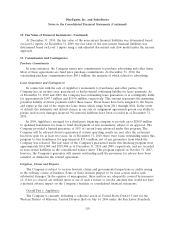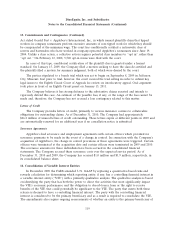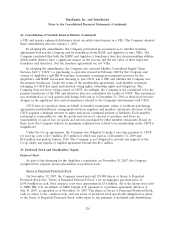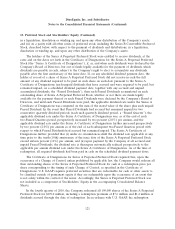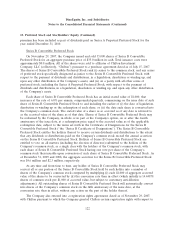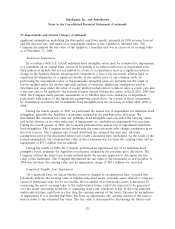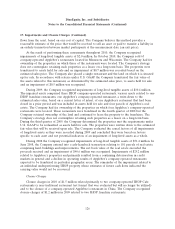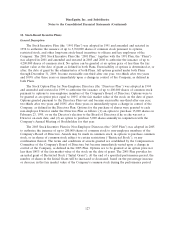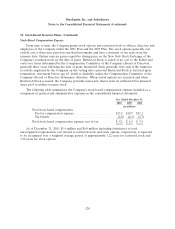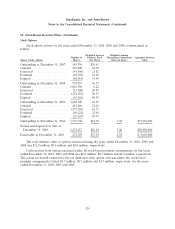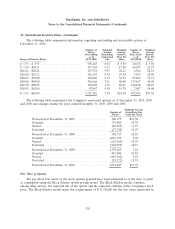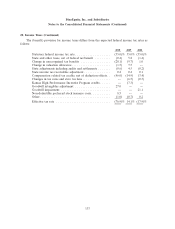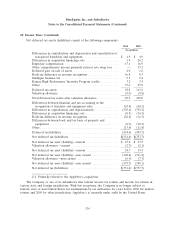IHOP 2010 Annual Report Download - page 141
Download and view the complete annual report
Please find page 141 of the 2010 IHOP annual report below. You can navigate through the pages in the report by either clicking on the pages listed below, or by using the keyword search tool below to find specific information within the annual report.DineEquity, Inc. and Subsidiaries
Notes to the Consolidated Financial Statements (Continued)
17. Impairments and Closure Charges (Continued)
significant assumptions underlying the discounted cash flows model, primarily its 2009 revenue forecast
and the discount rate, and updated its impairment analysis of the Applebee’s franchise unit. The
Company determined the fair value of the Applebee’s franchise unit was in excess of its carrying value
as of December 31, 2008.
Tradename Impairment
In accordance with U.S. GAAP, indefinite-lived intangible assets must be evaluated for impairment,
at a minimum, on an annual basis, and more frequently if we believe indicators of impairment exist.
Such indicators include, but are not limited to, events or circumstances such as a significant adverse
change in the business climate, unanticipated competition, a loss of key personnel, adverse legal or
regulatory developments, or a significant decline in the market price of our common stock. In
performing the impairment review of the tradename intangible asset, we primarily use the relief of
royalty method under the income approach method of valuation. Significant assumptions used to
determine fair value under the relief of royalty method include future trends in sales, a royalty rate and
a discount rate to be applied to the forecast revenue stream. During the course of fiscal 2010, 2009 and
2008, the Company made periodic assessments as to whether there were indicators of impairment,
particularly with respect to the significant assumptions noted above. As a result of these assessments,
we determined an interim test of indefinite-lived intangibles was not necessary in either 2010, 2009 or
2008.
During the fourth quarter of 2010, we performed the annual test of impairment for indefinite-lived
intangibles, primarily the Applebee’s tradename assigned in the purchase price allocation. We
determined the estimated fair value our indefinite-lived intangible assets exceeded the carrying values
and in the absence of no other indicators of impairment we concluded no impairment was necessary.
During the fourth quarter of 2009, the Company performed the annual test of impairment indefinite-
lived intangibles. The Company revised downwards the same-restaurant sales change assumption in its
five-year forecast. The Company also revised downward the assumed discount rate. All other
assumptions used in the discounted relief from royalty calculation were unchanged. As the result of the
revised assumptions, the estimated fair value of the tradename was less than the carrying value and an
impairment of $93.5 million was recognized.
During the fourth of 2008, the Company performed an impairment test of its indefinite-lived
intangible assets, primarily the Applebee’s tradename assigned in the purchase price allocation. The
Company utilized the relief from royalty method under the income approach to determine the fair
value of the tradename. The Company determined the fair value of the tradename as of December 31,
2008 was less than the carrying value and an impairment charge of $44.1 million was recorded.
Long-lived Tangible Asset Impairment
On a quarterly basis, we assess whether events or changes in circumstances have occurred that
potentially indicate the carrying value of tangible long-lived assets, primarily assets related to company-
operated restaurants, may not be recoverable. Recoverability of a restaurant’s assets is measured by
comparing the assets’ carrying value to the undiscounted future cash flows expected to be generated
over the assets’ remaining useful life or remaining lease term, whichever is less. If the total expected
undiscounted future cash flows are less than the carrying amount of the assets, this may be an indicator
of impairment. If it is decided that there has been an impairment, the carrying amount of the asset is
written down to the estimated fair value. The fair value is determined by discounting the future cash
125





